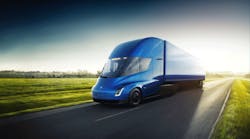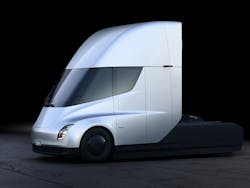Semi-truck companies have been trying for quite some time to cut fuel costs and chase the zero-emission dream through the use of hybrid technologies. But developments in electric-truck technologies are finally making headway in that direction, improving the chances of making these trucks viable from a business perspective.
At the unveiling of the Tesla Semi (see figure), Musk tried to give the impression that the technology for electric trucks has arrived and is ready to be commercialized. As usual, he delivered a great presentation of his new electric-truck project. It was announced that the Semi-truck, featuring a 500-mile range, will be able to accelerate from 0 to 60 mph in just 20 seconds while hauling 80,000 lbs.
No interesting details were revealed about the battery-pack specifications, but Musk said that its energy consumption will be less than 2 kWh/mile. This means that the battery pack will need an energy capacity of at least 1000 kWh. But how long will it take to be charged? According to Musk, the battery pack will charge up in an astonishing 30 minutes using the new Tesla Megacharger—it will have 10X the power levels of the company’s Supercharger.
A Trumped-Up Charge?
The claims made by Tesla’s CEO are beyond current battery-technology advances and understanding, which raises doubts about their feasibility. Without the details, it’s hard to believe that Tesla will be able to successfully commercialize an electric truck with a battery that might weigh more than 10,000 pounds based on an energy capacity of 1000 kWh.
The Tesla Semi uses four electric motors derived from the Model 3; one for each rear wheel. (Courtesy of USA Today)
Additionally, Tesla stated that it will guarantee electricity rates of 7 cents per kilowatt-hour, prompting questions from electricity experts (who are skeptical). Tesla plans to make good on that promise by adding proprietary solar power and massive battery packs at charging stations, and subsidizing electricity rates for customers.
The first Tesla Semi will not hit the road until late 2019, but it’s worth noting that the company is still struggling to meet the production target for the Model 3 sedan. That hasn’t stopped companies from pre-ordering Semis, though. For example, DHL announced that had ordered 10 trucks to test at customer facilities in major U.S. cities.
"At DHL Supply Chain, we're always thinking beyond today's shipment—whether that be thinking about tomorrow, next month or two years from now when these trucks become available," says Jim Monkmeyer, President of Transportation at DHL Supply Chain North America. "This is a revolutionary approach to trucking, and we want to be a part of it for our customers, for our employees, and for our industry.
“The trucks will be used for shuttle runs and same-day customer deliveries, and will be tested for fuel efficiency on longer runs from major markets to other DHL operations across the country,”
The claims made during the unveiling of the Tesla Semi caused many to question the capabilities of the batteries and the overall plans to expand the electric-truck market. Nonetheless, the electric- and hybrid-truck population is expected to exceed 1.6 million in the next decade, according to Navigant Research. As a result, don’t expect any slowdown of advances in the truck market any time soon.


